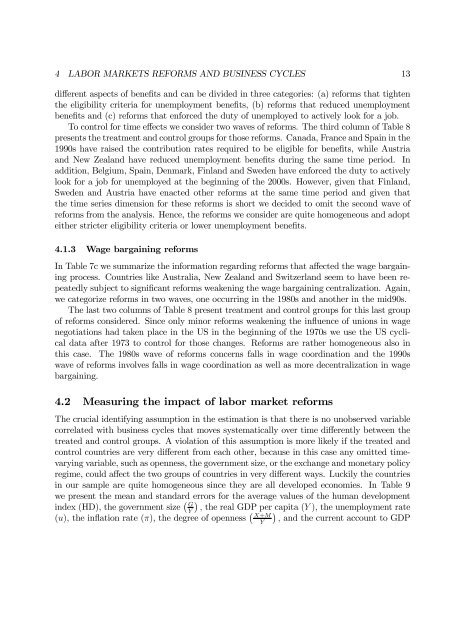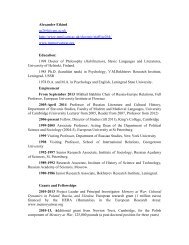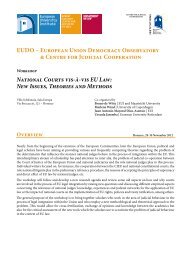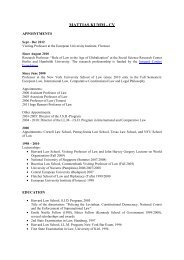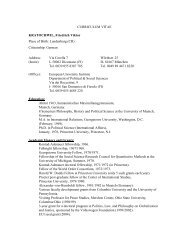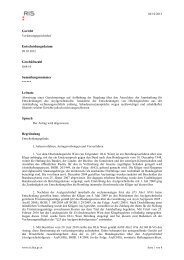Do labor market institutions matter for business cycles?∗ - European ...
Do labor market institutions matter for business cycles?∗ - European ...
Do labor market institutions matter for business cycles?∗ - European ...
Create successful ePaper yourself
Turn your PDF publications into a flip-book with our unique Google optimized e-Paper software.
4 LABOR MARKETS REFORMS AND BUSINESS CYCLES 13<br />
different aspects of benefits and can be divided in three categories: (a) re<strong>for</strong>ms that tighten<br />
the eligibility criteria <strong>for</strong> unemployment benefits, (b) re<strong>for</strong>ms that reduced unemployment<br />
benefits and (c) re<strong>for</strong>ms that en<strong>for</strong>ced the duty of unemployed to actively look <strong>for</strong> a job.<br />
To control <strong>for</strong> time effects we consider two waves of re<strong>for</strong>ms. The third column of Table 8<br />
presents the treatment and control groups <strong>for</strong> those re<strong>for</strong>ms. Canada, France and Spain in the<br />
1990s have raised the contribution rates required to be eligible <strong>for</strong> benefits, while Austria<br />
and New Zealand have reduced unemployment benefits during the same time period. In<br />
addition, Belgium, Spain, Denmark, Finland and Sweden have en<strong>for</strong>ced the duty to actively<br />
look <strong>for</strong> a job <strong>for</strong> unemployed at the beginning of the 2000s. However, given that Finland,<br />
Sweden and Austria have enacted other re<strong>for</strong>ms at the same time period and given that<br />
the time series dimension <strong>for</strong> these re<strong>for</strong>ms is short we decided to omit the second wave of<br />
re<strong>for</strong>ms from the analysis. Hence, the re<strong>for</strong>ms we consider are quite homogeneous and adopt<br />
either stricter eligibility criteria or lower unemployment benefits.<br />
4.1.3 Wage bargaining re<strong>for</strong>ms<br />
In Table 7c we summarize the in<strong>for</strong>mation regarding re<strong>for</strong>ms that affected the wage bargaining<br />
process. Countries like Australia, New Zealand and Switzerland seem to have been repeatedly<br />
subject to significant re<strong>for</strong>ms weakening the wage bargaining centralization. Again,<br />
we categorize re<strong>for</strong>ms in two waves, one occurring in the 1980s and another in the mid90s.<br />
The last two columns of Table 8 present treatment and control groups <strong>for</strong> this last group<br />
of re<strong>for</strong>ms considered. Since only minor re<strong>for</strong>ms weakening the influence of unions in wage<br />
negotiations had taken place in the US in the beginning of the 1970s we use the US cyclical<br />
data after 1973 to control <strong>for</strong> those changes. Re<strong>for</strong>ms are rather homogeneous also in<br />
this case. The 1980s wave of re<strong>for</strong>ms concerns falls in wage coordination and the 1990s<br />
wave of re<strong>for</strong>ms involves falls in wage coordination as well as more decentralization in wage<br />
bargaining.<br />
4.2 Measuring the impact of <strong>labor</strong> <strong>market</strong> re<strong>for</strong>ms<br />
The crucial identifying assumption in the estimation is that there is no unobserved variable<br />
correlated with <strong>business</strong> <strong>cycles</strong> that moves systematically over time differently between the<br />
treated and control groups. A violation of this assumption is more likely if the treated and<br />
control countries are very different from each other, because in this case any omitted timevarying<br />
variable, such as openness, the government size, or the exchange and monetary policy<br />
regime, could affect the two groups of countries in very different ways. Luckily the countries<br />
in our sample are quite homogeneous since they are all developed economies. In Table 9<br />
we present the mean and standard errors <strong>for</strong> the average values of the human development<br />
index (HD), the government size <br />
G<br />
Y , the real GDP per capita (Y ), the unemployment rate<br />
(u), the inflation rate (π), the degree of openness <br />
X+M<br />
Y , and the current account to GDP


